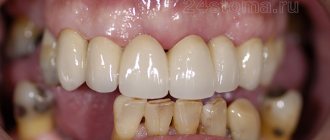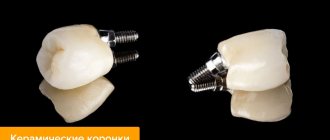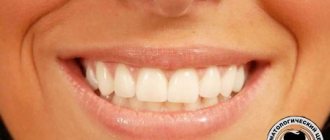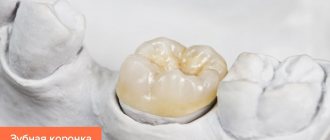- What kind of crowns are placed on teeth?
- Is it painful to grind down a tooth for a crown?
- Read more about teeth grinding
There are several reasons for using crown prosthetics.
Let us remind you that a crown is a tool for single prosthetics, which is used in the following cases: pathological pigmentation of teeth, violation of its anatomical shape, cracks, destruction of the coronal part by more than 60% of the tissue volume. To install a crown, the patient will need to go through the following steps:
- Diagnostics.
- Preparation of the tooth stump.
- Taking impressions.
- Making a crown.
- Fitting and final installation.
What kind of crowns are placed on teeth?
The following prostheses are used for dental prosthetics with crowns:
- Metal-ceramic is a budget-friendly, strong and durable crown option. The base of the prosthesis is metal, the top lining is ceramic. This ensures its strength and external aesthetics.
- All-ceramic - crowns for the front teeth are made from ceramic, since the material is not suitable for the significant chewing loads that are inherent in the lateral and chewing teeth.
- Zirconium dioxide is a premium material in modern orthopedics, used to restore both anterior and chewing teeth, as it has unsurpassed strength and naturalistic aesthetics today.
Classification of dental crowns
Modern medicine does not stand still, and today a very wide variety of crowns of various types and materials has appeared.
According to their purpose, crowns can be of two types: restorative (a complete, functional and aesthetic product) and supporting (used to secure a “bridge”).
The crown can be made from the following materials:
- metal;
- metal composite;
- metal ceramics;
- ceramics;
- porcelain;
- zirconium.
Also, each crown is graded according to design:
- full crowns. Used to completely restore a lost tooth;
- equatorial crowns. A metal plate that covers the tooth to preserve its tissues and shape (partial damage to the tooth);
- stump crowns. A crown built onto the gum;
- half-crowns They completely replace the tooth on all sides and can also serve as a support for a “bridge”;
- telescopic crowns. They differ in that their height after installation can be adjusted (relative to the gum);
- pin, jacket, etc.
What is meant?
Metal ceramics – two-layer prosthesis. The bottom layer is metal, the top layer is ceramic lining. In any case, such a product cannot be “thin”. This means that in order for the artificial tooth to be the ideal size, the stump will have to be considerably ground. In most cases, preparation will require depulpation of the nerve. Naturally, all this is done under local anesthesia, and the patient does not feel pain. Let us immediately note that while the dental technicians are making the prosthesis, the doctor will cover the ground tooth with a temporary “cap” in order to avoid hyperesthesia, a reaction to cold or hot.
Zirconium is not only the most durable and beautiful, but also the thinnest prosthesis. To install a zirconium dioxide crown, the tooth can be ground only slightly. In most cases, pulp preparation is not required. Many patients refuse anesthesia because there is no pain during the process of removing the top layer of enamel. If a person has a low pain threshold, then doctors use local or topical anesthesia so that the person feels physically and emotionally comfortable.
The thickness of the ceramic crown is average - between “thick” metal ceramics and “thin” zirconium. This means that the degree of grinding, and as a result, the level of trauma of the procedure, is determined individually in each specific case.
Author:
Mayorov Andrey Mikhailovich
Specialization:
orthopedic dentistry, dental prosthetics, implant installation
Does it hurt to insert teeth?
Typically, patients are interested not only in how a crown is placed on a tooth, but also how painful it is. The most unpleasant stages here, of course, are preparing teeth for prosthetics (i.e., treating them, filling root canals), and sometimes also the process of taking impressions. If already dead teeth are used for crowns, then turning them is completely painless and does not even require anesthesia. If living teeth are ground down, a local anesthetic is first injected.
The only painful moment that I myself (being a dentist) have personally experienced is when, when taking an impression, the doctor performs gum retraction. Retraction refers to the widening and deepening of the gingival sulcus, which is accompanied by a small degree of separation of the soft gum tissue from the tooth. This is done in order to make a more accurate impression of the neck of the tooth, and it is better to do this immediately under anesthesia.
What methods of hard tissue preparation exist?
Despite the development of progressive technologies, today in dental practice doctors carry out the preparation of hard tissues in 99% of all cases using a conventional drill and a diamond tip mounted on it. The procedure is similar to drilling out caries. Less commonly used are laser or ultrasonic methods, as well as air abrasive and chemical methods - all of them are applicable only if it is necessary to remove a minimum amount of tissue, but bur is suitable for any clinical situations.
Complications after filing teeth
If the manipulation is carried out in a dental office under the guidance of a qualified specialist, there is a small chance of a mild complication in the form of a temporary increase in sensitivity. All reviews of teeth filing prove that the side effect goes away quickly and does not cause concern.
To avoid any complications and side effects, you should not try to file your teeth at home. Attempts to use improvised tools to correct the dentition often cause chipping of enamel particles, the appearance of cracks and damage to several teeth at the same time. Successful and high-quality sharpening of teeth is possible only with diagnostics, professional dental instruments and therapeutic agents.
Taking impressions and making crowns
An impression is taken of the prepared dental units. For this procedure, a special dental plastic mass is used. An impression is necessary to make an exact plaster copy of the patient’s teeth, which will be used to create a permanent structure. For the production of crowns, different types of materials can be used - metal, metal-ceramics or ceramics. The specific type of raw material is selected based on the characteristics of the case and the wishes of the patient.
The production time for dental crowns depends on the type of material chosen. The production process of ceramic and metal-ceramic products takes the longest. If structures made from these materials are chosen for prosthetics, then temporary dental crowns made of plastic are made for the patient during the period of their manufacture. Temporary crowns will help to recreate the aesthetics of the dentition and, in addition, will protect the ground and weakened teeth from the destructive effects of external factors.
Stages of the procedure for installing a crown
The crown installation procedure is usually carried out in two stages.
Each stage is carried out separately, and the patient visits the dentist twice to install the crown.
The first stage includes: 1) preparing (grinding) the tooth, 2) taking an impression of the tooth, and 3) installing a temporary crown. The duration of the procedure is from 30 minutes to one hour.
Between the patient's two visits to the dentist, the crown is made in the laboratory of the adult dentistry clinic. This process usually takes about two weeks.
In the second stage, the dentist places the finished crown on the tooth, using filling material to secure it. The procedure takes about 20 minutes.
One-stage crown installation .
A variation of the main method is to install a crown in one step. If the dentist has all the necessary equipment at his disposal, the procedure will take an hour or two.
The first stage of crown installation
Preparing your teeth
Before the crown procedure begins, the dentist anesthetizes both the tooth and the surrounding gum area.
If the root of the dental canal is sealed, dental anesthesia is not needed. However, the dentist may consider it necessary to anesthetize the gums.
Preparation (grinding) of the tooth.
The tooth must be ground on all sides to reduce its size, since crowns must have a certain minimum thickness to ensure sufficient strength. Most crowns are about two millimeters thick. If the crown is porcelain, then the thickness of the porcelain layer should be sufficient to create visible natural translucency.
Additional reduction in tooth size.
During the process of grinding a tooth, the dentist is obliged to remove all damage from it, including poorly installed, “wobbly” or poor-quality fillings. As a result, most of the tooth may be removed. (There is no need to worry about this. The crown will be thicker in such areas).
The closer the tooth is in contact with the inside of the crown (the greater the correspondence between the contacting surfaces), the more firmly the crown will hold.
The prepared tooth must have a certain shape.
The dentist not only reduces the size of the tooth, he gives it the desired shape. The tooth must have a cone shape with a slight bevel angle so that a crown (a hard, inflexible shell) can be placed on it.
The correct shape of the ground tooth should ensure a tight fit and good fixation of the crown.
For a quality installation, it is not enough to simply place the crown on the filling material. The shape of the tooth is of great importance in ensuring a tight fit and reliable fixation of the crown.
The closer the shape of the ground tooth matches the shape of the inside of the crown, the better the crown will hold.
In cases where a large portion of the tooth is missing or significantly damaged, the dentist “builds on” the tooth with filling material (enlarges it) before filing the crown.
After grinding the tooth, the dentist must make an impression of it by applying impression material.
Most dentists use a special paste or powdered substance as an impression mass that has the properties of an impression mass.
It is also necessary to take impressions of the teeth located opposite the ground tooth (that is, the teeth that will come into contact with the crown when chewing). A bite impression is also taken to determine at what angle the patient's teeth meet.
How is the impression used?
The finished impression is sent to a dental laboratory, where a plaster copy is made of it to make a crown.
A plaster copy is an exact reproduction of the crowned tooth and adjacent teeth. Therefore, if the crown is made according to the dimensions of the copy, it will fit exactly on the tooth. In some cases, minor adjustments are still required.
Depending on the individual characteristics of the tooth, the work on making a crown in the laboratory takes about two weeks.
In addition to the procedure:
Some dentists have state-of-the-art milling machines that can be used to design and fabricate a crown right in the office.
Installation of a temporary crown
If the crown is made in a laboratory, you will have to wait about two weeks. At this time, you can install a temporary crown.
A temporary crown will protect your teeth and prevent them from moving.
A temporary crown is usually made of plastic, sometimes a metal-ceramic crown is available. Sometimes, for this purpose, blanks are taken and adjusted to a specific tooth, or they are made according to the dentist’s sketch.
The temporary crown is secured with a filling compound, which is easily removed before installing the permanent crown.
Choice of crown color.
If your new crown has a porcelain surface, your dentist will need to determine what shade of porcelain matches the color of the teeth adjacent to the crown.
The dentist uses a set of small samples in the form of teeth of different shades. This set of samples is called a “shade palette.”
Individual samples are applied in turn to the place where the crown will be installed, and the most suitable one is selected.
Crown installation stage.
Once the crown is made, the dentist can begin installing it.
- Removing the temporary crown
At this stage it is necessary:
Give anesthesia. This stage is not always necessary. Often the process of installing and securing the crown is painless for the patient.
Remove the temporary crown and remove any remaining filling material from the tooth.
- Assessing suitability and appearance of the crown.
Before placing a crown, the dentist must ensure that it is suitable and in good appearance. The assessment process includes:
Checking the strength of the attachment - the dentist places the crown on the tooth and checks the tightness of the fit using dental floss and tapping the tooth with an instrument, while the patient is asked to slightly squeeze the teeth.
After this, the doctor removes the crown, then puts it on again, slightly changing its position, removes it again, and this is repeated several times until the crown takes the desired position relative to adjacent and opposite teeth.
Checking the appearance. – Additionally, and in some cases mandatory, for example, when a dental crown is visible when you smile, the dentist should give you a mirror and ask you to evaluate the shape and color of the crown.
Do not hesitate to express your opinion and ask the doctor questions, and this must be done before the filling material hardens, then it will no longer be possible to make some changes (such as color changes and even some shape changes).
Planting the crown on cementing material
- Cementing the crown
If both you and the dentist feel that the crown is installed correctly and looks good, cementation can be done. For this:
Dental cement is placed inside the crown, after which it is placed on the tooth.
When the cement begins to harden, the dentist uses a dental instrument and scrapes off the excess cement that protrudes beyond the edges of the crown.
This completes the crown placement procedure.
Precautions after placing a crown
The dentist will explain to you what to do in the first hours after the crown is placed. For example, when using some types of dental cement, it is recommended to avoid impacting the crown (avoid eating too hard or sticky foods) until the cement has fully cured.
After administering anesthesia, caution should be exercised until the numbness subsides. Otherwise, you may bite your lip or cheek, and quite hard.
After the numbness has passed, the next day or a little later, lightly clench your teeth to make sure that the crown does not cause discomfort when opening and closing your mouth. If you feel discomfort, tell your dentist and he will correct the problem (usually by grinding the surface of the crown). If this is not done, complications, sometimes serious, are possible.
When is a doctor needed?
If your teeth ache for longer than 7 days after grinding, you should make an appointment with your doctor. The reason for contacting a specialist may also be:
- inflammation and bleeding of gums,
- the appearance of neoplasms on the mucous membrane,
- bad breath,
- pain when chewing and brushing teeth.
The listed symptoms cannot be ignored. Even with minor discomfort, it is better to consult a doctor to exclude the development of serious diseases.
How painful is the procedure?
The procedure is unpleasant psychologically, but the preparation will be carried out only after the doctor gives you anesthesia - the anesthetic is given even when the grinding is minimal or when the tooth is already “dead”, i.e. it lacks a nerve. This will help you feel absolutely no pain or discomfort in the dentist’s chair. True, some patients, after the effect of anesthesia wears off, note the occurrence of pain reactions. In most cases, pain occurs when a sufficiently large layer of tissue is removed, i.e. before prosthetics with crowns or bridges. Then this is a natural phenomenon that is associated with interference in the living tissues of the body. After all, during the preparation, the doctor used a drill, which heated the tissue and pushed back the gum in order to create a ledge.
The unpleasant sensations should pass soon, but if they continue to bother you for more than 3-5 days and increase in intensity, then be sure to see a doctor. Perhaps the specialist made mistakes when grinding hard tissues, which resulted in an inflammatory process.








